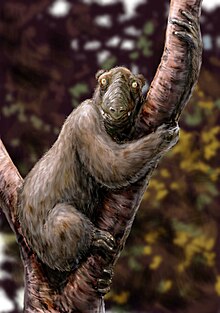Megaladapidae
| Megaladapis | |
|---|---|
 |
|
| Megaladapis edwardsi | |
|
Extinct (1280–1420 CE)
|
|
| Scientific classification | |
| Kingdom: | Animalia |
| Phylum: | Chordata |
| Class: | Mammalia |
| Order: | Primates |
| Suborder: | Strepsirrhini |
| Family: | †Megaladapidae |
| Genus: |
†Megaladapis Forsyth Major, 1894 |
| Species | |
|
Subgenus Peloriadapis
Subgenus Megaladapis
|
|
Subgenus Peloriadapis
Subgenus Megaladapis
Megaladapis, informally known as koala lemur, is an extinct genus belonging to the family Megaladapidae, consisting of three extinct species of lemurs that once inhabited the island of Madagascar. The largest measured between 1.3 to 1.5 m (4 to 5 ft) in length.
Megaladapis was quite different from any living lemur. Its body was squat and built like that of the modern koala. Its long arms, fingers, feet, and toes were specialized for grasping trees, and its legs were splayed for vertical climbing. The hands and feet were curved and the ankles and wrists did not have the usual stability needed to travel on the ground that most other Lemurids have. Megaladapis is perfectly evolved to live in an arboreal environment by its pedal morphology. Its foot have large hallux and lateral abducctor musculature that helps it grasping vertically on the trees. In other species which is adepted in an arboreal environment can also found the similar pedal design. Its head was unlike any other primates, most strikingly, its eyes were on the sides of its skull, instead of forward on the skull like all other primates.
Its long canine teeth and a cow-like jaw formed a tapering snout. Its jaw muscles were powerful for chewing the tough native vegetation. Megaladapis is suggested to have been survived on a folivorous diet, using a leaf-cropping foraging method, based upon the microwear patterns of its teeth. These patterns found no permanent upper incisors or the presence of an expanded articular facet on the posterior face of the mandibular condyle. This diet and similar phenotypic traits of the teeth are the basis for concluding a shared ancestry with the Lepilemur. The diet, however, might be the factor that influences the dental development. Species with a larger brain, later initiation of molar crowns, and longer formation of crown are considered to have more of an omnivorous diet. In contrast, Megaladapis is on a folivorous diet, despite having a smaller brain, early initiation of molar crowns, and fast crown formation.
Its body weight reached 50 kilograms (110 lb). The shape of its skull was unique among all known primates, with a nasal region which showed similarities to those of rhinoceros, what was probably a feature combined with an enlarged upper lip for grasping leaves. Its body size was the largest among other lemurs. Compared to the next extinct lemur, Megaladapis had double their mass. However, its brain was small, compared to other lemurs, shown by its mass to brain size ratio. An endocast of the skull was taken and it was found that the brain capacity was about 250cc. This is about 3 to 4 times the size of a common cat's. Compared to the size of the skull, the diameter of the orbits protrudes in a tabular form outwards and forwards, suggesting that the Megaladapis was diurnal. The gestation length of Megaladais is approximately 198 days at the minimum. It is more likely longer than that. It is calculated by the time when initiation of molar crown occurred. The later of crown initiation occurred, the longer the length of gestation if it occurred after three months.
...
Wikipedia
